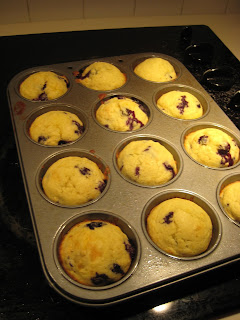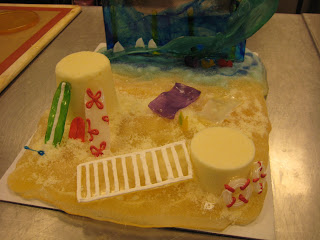David Chang (FCI '01) and his ever-growing Momofuku empire have been an inescapably omnipresent force in Manhattan dining over the last few years, the most recent honor being Momofuku Ko's Best New Restaurant win at the James Beard Awards earlier this week. As a pastry chef, I was intrigued by Momofuku Milk Bar, the latest empire outpost, and when the FCI offered a student outing to the bakery I signed up right away.
From the street, the Milk Bar is an unassuming East Village glass storefront, close enough to the other Momofukus that customers will come over and have a drink while waiting for a table in the evenings. Inside, the space is dominated by two long wooden table/counters that customers stand at, two big black chalkboards with the current menu, and a glass case displaying the day's wares.

No sooner had we gathered around around one of the long counters than a cheerful employee brought trays of goodies out for us to try. We started with an assortment of cookies - blueberry cream cheese, banana bread, double chocolate, cornflake, and my favorite - the compost cookie. All the cookies were great - crispy on the outside, soft and fudgy on the inside - but the combination of sweet and salty in the compost cookie really hit the spot. It isn't literally composed of compost, of course, but it does boast an interesting assortment of savory surprises - potato chips, bread crumbs, pretzels - check out the cross-section below!

From cookies we moved on to cakes - chocolate chip with passion curd, dulce de leche, and a fantastic banana cake with gianduja filling and pieces of crispy feuilletine. The Milk Bar also sells an ever-rotating array of soft-serve ice cream; the four flavors we had were all based on types of donuts: jelly, old fashioned, chocolate, and bavarian cream. All the ice creams, with the disappointing exception of the chocolate, were very good, and tasted a startling amount like their inspirations.
Next were the pies - candy bar pie, cinnamon bun pie, and the dish that has already become a Momofuku signature, crack pie. Personally, I found the crack pie to be terribly overrated and not nearly as addictive as its namesake. It is very sweet and very gooey, but not very interesting. It reminded me a little of the St. Louis treat "ooey gooeys" that our crew captain in college made for team snacks, but not nearly as good.
The cinnamon bun pie, on the other hand, was surprisingly fantastic. I'm often not a big fan of commercial cinnamon buns - they're too heavy, too dry, too greasy, or not worth the astronomic calorie count. The Momofuku version has none of these flaws. Head pastry chef Christina Tosi brought a plate out to our group and explained the dish's genesis. When the Milk Bar first opened, they were serving individual cinnamon buns, but the super-popular dish was very labor-intensive and time consuming.
Transforming the bun into pie form made it easier to assemble, store, proof, and bake, without losing any deliciousness in translation. A slightly sweet bread dough forms the base of the pie, and is layered with whipped brown butter, the Milk Bar's liquid cheesecake, and cinnamon sugar (x2), then topped off with an oat streusel. Served warm from the oven, the "crust" is light and flaky, the filling oozes just enough, and the streusel provides the perfect crunchy counterpoint. Hands down the best thing I ate all afternoon.

Our Milk Bar journey took a detour to the savory side towards the end of our trip, with banana green curry bread and the Milk Bar's own kimchee and black pepper butter. The curry in the bread was hardly noticeable, but it had a beautiful moist texture and a slightly sweet banana flavor that was a nice foil for the intense savory punch of the butters. The kimchee butter reminded me more of smoky bbq chips than spicy cabbage, but was delicious all the same, while the black pepper butter had a Mediterranean tang of olive oil and parmesan.
Throughout the visit, I was trying to decide how to categorize or sum up the Milk Bar's offerings, other than delicious. Surprising, inventive - but not really, since most of the items were using flavors or flavor combinations that were established favorites. Where the Milk Bar seems to shine is taking those classics and reinventing them in other media - ice cream out of donut flavors, a blueberry-cream cheese cookie taking inspiration from a blueberry muffin top, candy-bar and cinnamon bun pies, cookies with pretzels. Your favorite flavors, made new again.
Our final dish at the Milk Bar was another signature and a popular breakfast item - the Momofuku pork bun with a deep-fried poached egg and pickled cucumbers. As I've already mentioned on this blog, I have a soft spot in my heart for some deep-fried things. While I don't think I'll be trying this one at home anytime soon, it was quite delicious, and a perfect way to end the visit (and stave off a serious sugar crash on the walk home).














































